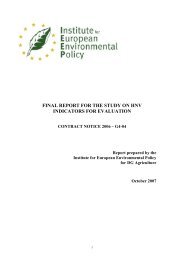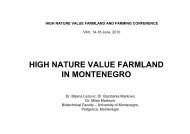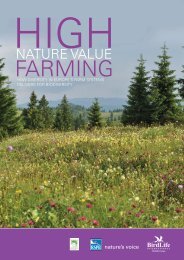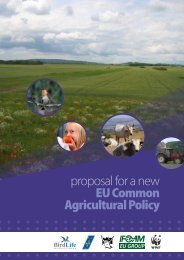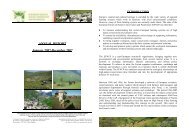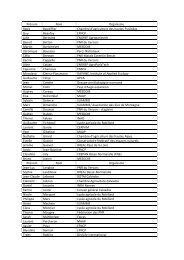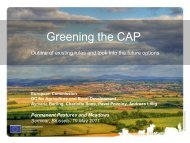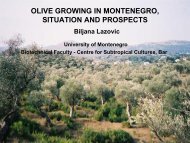RODICS Gergely, Pogány-havas Association, RO - EFNCP
RODICS Gergely, Pogány-havas Association, RO - EFNCP
RODICS Gergely, Pogány-havas Association, RO - EFNCP
Create successful ePaper yourself
Turn your PDF publications into a flip-book with our unique Google optimized e-Paper software.
The Pogány-<strong>havas</strong> Regional <strong>Association</strong>• Founded in 1999• Members:- The Harghita County Council- 6 municipalities (33 villages)- 11 NGOs- 9 local enterprises• 23,000 residents• of which 36% Székely, 64% Csángó, both Hungarian minorities• and a very small number of Romanians and Gypsies
Goals and fields of activityOur main goal is to initiate and execute rural developmentin the area, paying special attention to:– Environment– Agriculture– Tourism– Cultural heritageand traditionsin continuous co-operation with local citizens.
The area
Land managementCsíkGyimes– Csík basin: 638 to 757 m;– Alpine, up to 1400 m– Plough lands 20%– Meadow 34%– Pasture 22%– Forest 25%47%– Plough lands 2%– Meadow 27%– Pasture 33%– Forest 38% 71%
Uniqueness of Pogány-<strong>havas</strong> and Transylvania• Very high species richness• Very large areas (thousands of square kms)• The management regime is: extensive farming,i.e. managing so vast HNV areas would not bepossible by nature conservation bodies
Hay meadow biodiversity• World record:– Mountain hay meadows are among the most biodiverseareas in the world:under 100 m² scale no other habitat on Earth is asrich in vascular plants• Pogány-<strong>havas</strong> records:– Local ecological knowledge: highest number in the wordof distinguishing habitats in the local language– Number of plant species in a 16m 2 quadrate: third placein the EU, second in Transylvania– As much butterfly species on one meadow as in thewhole of UK (Spring et. al., 2011)
Pogány-<strong>havas</strong> plant species numbers• In Gyimes (12 years of research)– Altogether 617 plant species found so far– 390 species on grasslands (63% of all)– 81 species in a 16m 2 quadrat (3 rd place in Europe)• In Csík (1 year of research, june-july only)– Pastures: 178 plant species– Meadows: 307 plant speciesIn 1x1 m quadrats:– Used meadows: 40 ± 7 (average ± SD)– Abandoned meadows: 31 ± 7– Pastures: 30 ± 6– Maximum species no. on one pasture: 50
Pogány-<strong>havas</strong> plant species composition• 38 internationally or nationally protected species• 33 red listed species• 12 endemic species• Elevation has positive effect on species richnessincl. endemic species
Threat: AbandonementMountain hay meadows measured in the Pogány-<strong>havas</strong> area in 2011,35 km 2
Threat: AbandonementMountain hay meadows mown (with green) in 2011,4,3 km 2 , 14% (!)
Reasons for abandonement• conversion of arable land into hay fields near the village• decrease of cow numbers,• concentration of cows to fewer owners with a more intensive typeof production (no grazing on pastures, high energy fodder, silage),• large distance of the mountain meadows from the settlement, oftenmore difficult access and way of transporting hay down themountain,• ageing population.
Location of sheepfold in 1992Threat: Grazing
Location of sheepfold in 2012Threat: Grazing
Rate of biodiversity degragation• Abandonement:– In 2-5 years since abandonment in Csík, diversitydecreased with a minimum of 2-3 species,– 21-57% loss in 10-20 years were reported from otherparts of Europe (Losvik, 1999)• Pastures compared to hay meadows– Species numbers are significantly less, almost half– Based on our butterfly research in 2011• species number on a 100 m transect: 1/4th• no. of individual on a 100 m transect: 1/8th
Recommendations• stimulating a market for milk and other products of localcattle farming, including beef;• creating new markets for hay;• removing the barriers to production and marketing;• introducing a separate hay meadow package and mountainhay meadow supplement in the agri-environment schemeswhich reflect the higher nature value, ecosystem servicesand management costs of this important and threatenedland use type; and• improving agri-environment schemes to increase theireffectiveness and uptake. (???)
Thanks for your kind attention!Rodics <strong>Gergely</strong>office@pogany<strong>havas</strong>.rowww.pogany<strong>havas</strong>.ro



